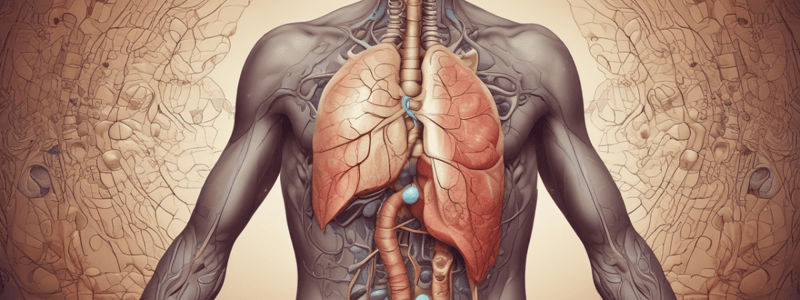Podcast
Questions and Answers
What is the primary function of the respiratory center in the brainstem?
What is the primary function of the respiratory center in the brainstem?
- To generate the rhythmic pattern of inspiration and expiration (correct)
- To regulate heart rate
- To monitor body temperature
- To control blood pressure
During inspiration, what is the direction of air flow into the lungs?
During inspiration, what is the direction of air flow into the lungs?
- From the nose or mouth into the windpipe (correct)
- From the alveoli into the blood vessels
- From the windpipe into the alveoli
- From the blood vessels into the thoracic cavity
What is the term for the process of exchanging oxygen and carbon dioxide between the air and the blood?
What is the term for the process of exchanging oxygen and carbon dioxide between the air and the blood?
- Internal respiration
- External respiration (correct)
- Pulmonary respiration
- Cellular respiration
Which muscle contraction is responsible for creating a negative pressure in the thoracic cavity during inspiration?
Which muscle contraction is responsible for creating a negative pressure in the thoracic cavity during inspiration?
What is the role of the respiratory muscles in lung expansion?
What is the role of the respiratory muscles in lung expansion?
What is the primary function of the preBötzinger Complex in the brainstem?
What is the primary function of the preBötzinger Complex in the brainstem?
What happens to the pressure within the thoracic cavity during inspiration?
What happens to the pressure within the thoracic cavity during inspiration?
Which muscles assist the diaphragm in facilitating breathing?
Which muscles assist the diaphragm in facilitating breathing?
What is the result of the diaphragm relaxing and returning to its domed resting configuration during expiration?
What is the result of the diaphragm relaxing and returning to its domed resting configuration during expiration?
What is the primary mechanism of gas exchange in the human body?
What is the primary mechanism of gas exchange in the human body?
Flashcards are hidden until you start studying
Study Notes
Breathing Mechanisms
Breathing is a vital physiological process that involves the inhalation of oxygen and the exhalation of carbon dioxide. The mechanism of breathing is complex and involves several organs and muscles. This article will discuss the key aspects of breathing mechanisms, including regulation, gas exchange, lung expansion, diaphragm movement, respiratory muscles, and brain involvement.
Breathing Regulation
Breathing is controlled by the respiratory center in the brainstem, which generates the rhythmic pattern of inspiration and expiration. The respiratory center receives input from peripheral chemoreceptors and mechanoreceptors in the lungs and blood vessels, allowing it to adjust the breathing rate and depth in response to changes in the body's oxygen and carbon dioxide levels.
Gas Exchange
During inspiration, the diaphragm and external intercostal muscles contract, creating a negative pressure within the thoracic cavity. This pressure difference causes air to flow into the lungs through the nose or mouth. The air then travels down the windpipe (trachea) and into the lungs, where it enters tiny air sacs called alveoli. In the alveoli, the air comes into direct contact with the blood vessels (capillaries) that surround them. This process, known as external respiration, allows for the exchange of oxygen and carbon dioxide between the air and the blood.
Lung Expansion
Lung expansion is achieved through the coordinated movement of several muscles. The diaphragm, a large, dome-shaped muscle that separates the thoracic cavity from the abdominal cavity, contracts and moves downward during inspiration. This movement increases the volume of the thoracic cavity, drawing air into the lungs. The external intercostal muscles, located between the ribs, also contract and pull the ribs upward and outward, further increasing the chest volume.
Diaphragm Movement
The diaphragm plays a crucial role in breathing. During inspiration, it contracts and moves downward, increasing the size of the thoracic cavity and decreasing the pressure within it. This results in a flow of air into the lungs. Conversely, during expiration, the diaphragm relaxes and returns to its domed resting configuration, causing the lungs to deflate and air to be expelled.
Respiratory Muscles
The respiratory pump is a group of primary and accessory inspiratory muscles that work together to facilitate breathing. The major respiratory muscle is the diaphragm, which is assisted by the external intercostal muscles, parasternal muscles, sternomastoid muscles, and scalene muscles.
Brain Involvement in Breathing
The brain plays a critical role in regulating breathing. The preBötzinger Complex (preBötC) in the brainstem is a rhythmic core of the breathing network, coordinating all phases of the breathing cycle. The preBötC also influences and is influenced by emotions and cognition.
In conclusion, the mechanisms of breathing are intricate and involve several organs and muscles working together to ensure the proper exchange of gases in the human body. Understanding these mechanisms can provide valuable insights into the functioning of the respiratory system and its role in maintaining overall health.
Studying That Suits You
Use AI to generate personalized quizzes and flashcards to suit your learning preferences.




